-

新人教版高中英语必修2Unit 5 Music-Listening and Speaking教案
This lesson is about music. Students can classify the types of music through the instruments and its sound and can talk about their preferences about music, even join some activities and play a role in them according to their musical talents. On the basis, they are guided to use the languages to express their preferences and some plosive sounds and their rules.1. Classify the music types through the instruments and its sound.2. Listen and understand what the speakers’ preferences are and the reasons; talk about their own preferences and give their own reasons, using these sentences: “What kind of music do you like? And why? “ “Because it makes/gives me energy/peaceful.../touches my heart...”.3. Learn some plosives and the rules.4. Join some activities and play a role in them according to the talents. 1. Listen and understand what the speakers’ preferences are and the reasons;2. talk about their own preferences and give their own reasons, using these sentences: “What kind of music do you like? And why? “ “Because it makes/gives me energy/peaceful.../touches my heart...”.3. Learn some plosives and incomplete plosives and its rules.Step 1 Lead inPoint at the pictures on P50 and ask Q1: What are the people doing in the pictures below?Q2: What kind of music they are?Then play the MP3s one by oneStep 2 ListeningTask 1: A reporter from the school newspaper is interviewing students about music. Listen to the interviews. Draw lines between the words to make complete sentences. Some words will not be used.

新人教版高中英语必修2Unit 5 Music-Reading and Thinking教案二
1. Get basic information about Eric; read deeply to understand the history and development of the virtual choir.2. Understand what the function of the virtual choir is and how to make a virtual choir.3. Understand the meaning of some languages in the context of the text through question guidance, such as “Many people do not have close friends or contacts who have the same interest in music.” and so on.Step 1 Leading-in1. Answer the following questions.Q1:Do you know the Apps like Tik Tok and Quick Hand?Q2: Do you want to make a Tik Tok video or a Quick Hand video?2. Play a Tik Tok video Step 2: Understanding the title Q1:What does the title mean ?Q2: Is the article a narration or exposition? Why? Q3: Can you change the title ? If you can, what is the title?Step 3: Scanning the whole text and getting the basic information1. Answer the following questions.Q1:Who came up with the idea for a virtual choir?Q2: Where did Eric studied the musical composition?Q3: What is his song?2. Find the main idea of each paragraph3. Deal with some new words.Step 4: Reading carefully to get detailed informationPara 1 How to make a virtual choir1. PreparationA. tools: a virtual camera; an Internet connectionB. hero/heroin: friends or some individuals who have the same interests2. Process
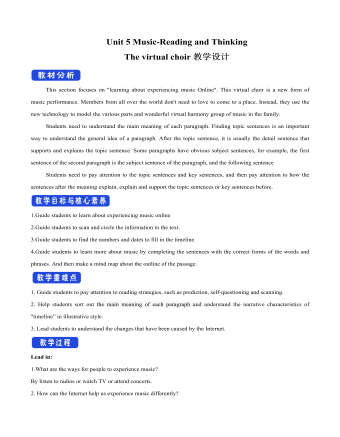
新人教版高中英语必修2Unit 5 Music-Reading and Thinking教案一
This section focuses on "learning about experiencing music Online". This virtual choir is a new form of music performance. Members from all over the world don't need to love to come to a place. Instead, they use the new technology to model the various parts and wonderful virtual harmony group of music in the family. Students need to understand the main meaning of each paragraph. Finding topic sentences is an important way to understand the general idea of a paragraph. After the topic sentence, it is usually the detail sentence that supports and explains the topic sentence. Some paragraphs have obvious subject sentences, for example, the first sentence of the second paragraph is the subject sentence of the paragraph, and the following sentenceStudents need to pay attention to the topic sentences and key sentences, and then pay attention to how the sentences after the meaning explain, explain and support the topic sentences or key sentences before.1.Guide students to learn about experiencing music online2.Guide students to scan and circle the information in the text.3.Guide students to find the numbers and dates to fill in the timeline.4.Guide students to learn more about music by completing the sentences with the correct forms of the words and phrases. And then make a mind map about the outline of the passage.1. Guide students to pay attention to reading strategies, such as prediction, self-questioning and scanning.2. Help students sort out the main meaning of each paragraph and understand the narrative characteristics of "timeline” in illustrative style.3. Lead students to understand the changes that have been caused by the Internet.

新人教版高中英语必修2Unit 5 Music-Reading for Writing教案二
The Internet celebrity Gao Yifeng. Years ago, he owned 5 companies and the staffs over 1,000, but during the economy crisis, he became nothing but debt. He was so worried that his hair became white overnight. There was a time when he wanted to killed himself. But after listening to the song Start Over by Liu Huan, he decided to cheer himself up. He started a steamed bun shop and gradually became a national chain shops. Now he became successful again.Walter Haddon said, “Music is the medicine of a troubled mind.” Music contains such a pleasant and inspiring force. Music gave him courage and bravery. When he listened to the song, it made his spirit fly like a kite in the wind. Music gave him strength and brought him relief. It was the rock I leant on to become strong and to get through those hard times. I hope none of us have to go through the same kind of suffering that he did. At the same time, we all go through various periods when we feel sad or alone. During those times, music can help us in the same way that it helped him. I hope we all will somehow begin to treasure music and make it a part of our life. Thank you for your listening !5.Revise your writing each other.Does he/she explain how music has changed his/her/someone else’s life?Are some of the rhetorical devices included and used properly ?Does he/she talk about how music makes him/her/someone feel?Is the first word in each sentences capitalised?Does he/she use correct punctuation ?

新人教版高中英语必修2Unit 5 Music-Reading For Writing教案一
(4)Now we have heard a number of outstanding speeches ... 我们已经聆听了许多精彩的发言……(5)Because we wanted the nations of the world, working together, to deal with ... 因为我们希望全世界各国团结起来去应对……(6)And if we do not act ... 如果我们不采取行动……(7)Now, I share the concerns that have been expressed ... 我也同意对于……表达的担心(8)Let us show the world that by working together we can ... 让我们告诉全世界,通过一起努力我们可以……(9)It is now time for us to ... 是时候我们……(10)And I have always wished that ... 我一直希望……(11)Thank you for letting me share this day with me.感谢你们和我共度这一天。实践演练:假如你是高中生李华,你校将举办一次以“音乐”为主题的演讲比赛,请你按照主题,写下你的演讲稿。注意:词数100左右。First of all, thank you for listening to my speech. My topic is: love music like love yourself.Music is like the air we need to maintain our normal lives around us. You can't imagine how terrible a world without music would be. Movies and TV shows have no music, only dry conversations and scenes; mobile phones only vibrations; streets only noisy crowds; cafes, western restaurants only depressed meals. What a terrible world it is!As a student, I hope we all can enjoy the fun brought by music in our spare time. Instead of just listening to music, we can even make our own music. Let's enjoy the fun of music!Thanks again for your attention!
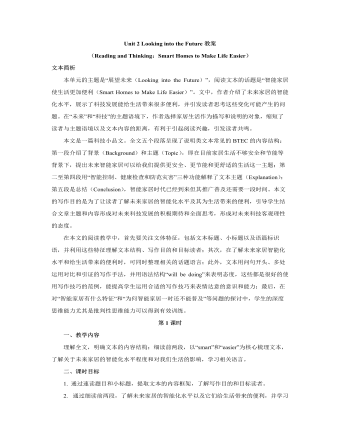
新人教版高中英语选修1Unit 2 Looking into the Future教案
【设计意图】以“新科技是一把双刃剑”为主题开展讨论活动。这个话题比较大,所以给了一定的限制,首先需要以智能家居为例来阐述科技发展对未来生活产生的影响,然后列举其优点和缺点,最后就以上现象发表自己的观点。这个活动是对整个文本的创意性总结与意义的升华,留给学生一定的想象空间,学生借此机会可以运用文本内容和语言表达自己对科技发展的看法和态度。Assignments:1. Finish Exercise 4 on Page 15 of the textbook.A smart home is one that integrated computers into the structure of the building itself. In this way, many of the things that we now do ourselves become automatic. For example, the smart home could control the air conditioning and lights so that you would no longer have to turn switches on and off, and so that your home would be more energy-efficient. The smart home could also monitor itself to make sure that everything is working as it should, and send you warnings if there is a problem. Such smart homes could even be programmed to detect your health problems, and then give you reasonable advice as to the food you should eat or if you should see a doctor. So, in a sense, smart homes will lead us to living smarter lives.2.Create a smart function for your home, and share your creation in the next period.

新人教版高中英语选修3Unit 2 Healthy Lifestyle教案
Activity 4: Figuring out the structure and the writing purpose 本活动为实现课时目标2。 1.Read Paragraph 6 and think about its main idea and the writer’s writing purpose. Q1: If you were the author, how would you end your article? “For young people, there is plenty of time to change bad habits. However, there is no “magic pill” or delete button that will help you; you have to think about your bad habits and decide on some changes. You have the power to build a happy and healthy life full of good habits!” Q2: What is Paragraph 6 mainly about? (Possible answer: to appeal to young people including teenagers to change bad habits and live a happy and healthy life.) 2.Think about the writer’s writing purpose and share opinions. Q1: What is the writing purpose? Work in pairs and figure it out. (Possible answer: On the one hand, the passage is written to help teenagers change their bad habits and live a healthy lifestyle. On the other hand, it provides us with a scientific way to identify and analyse our problems objectively, thus strengthening our resolve to tackle the seemingly common yet tough problems in our lives.) 【设计意图】 步骤1旨在预测和验证文章最后一段主要内容,梳理完整的语篇结构,步骤2旨在思考和讨论作者的写作目的。教师也可根据学生课堂反应情况融入对语篇人称多次转换的思考。

新人教版高中英语选修4Unit 2 Iconic Attractions教案
帮助学生通过讨论与对主题的提升,反思自己的旅游方式,以便做出更优化的安排,在今后的旅程中有更多的收益。 Activity 2: Further discussion of the 6 elements above and supplement of more background knowledge 本活动为实现课时教学目标2。 1.Target Q: The writer’s clear target of traveling, meeting the people and experiencing the culture, is closely related to his major in social studies. Then what is social studies? Social studies is a part of a school or college curriculum concerned with the study of social relationships and the functioning of society and usually made up of courses in history, government, economics, civics, sociology, geography, and anthropology. (Dictionary by Merriam-Webster) Reflection: When you go out to travel, what targets do you usually have in mind? 2.Research Q: Suppose you are traveling to Hangzhou during the school holidays, how will you do research on the city? (surf the internet, read books or travel brochures, consult friends, ...) What information will you be interested to know? (location, iconic sites, local cuisines, interesting customs, shopping malls ...) 3.Abandonment To make the most of time, we have to learn to abandon so that we can accomplish our plan. What will you be interested in doing if you go to Hangzhou if you have a week’s time? What if you only have 2 days? 4~5. Venturing & Experiencing Q: What did he venture to do during the trip? What new experiences did he have? In Sydney: attend his first open-air barbecue, enjoy many different but yummy meals In Catherine: observe the life and customs of the aborigines appreciate their music & try the musical instruments: the didgeridoo

部编人教版五年级上册《猎人海力布》说课稿
一、教材分析《猎人海力布》是一则在内蒙古自治区流传的民间故事,故事描写了善良、诚实的海力布,为了拯救乡亲们的生命,不惜自己变成一块石头。人们因此世世代代纪念他。这则故事虽然篇幅较长,但语言通俗易懂,围绕海力布“舍己救乡亲”的中心事件,层层铺垫,寓理寓情于故事中,给人强烈的感染和教育。本单元的训练重点是简要复述课文。从教材本身看,本课有以下特点:一是课题表明写人;二是情节生动,语言通俗易懂;三是想象力奇特丰富。二、教学目标分析要学生简要复述课文,首先要让学生熟悉课文内容,理清课文脉络,因此第一个教学目标定位为熟悉课文,了解事件的起因、经过、结果。要学生复述好课文,可以借助列小标题的方法理解课文内容、理清层次、找出要点。除了熟悉课文内容外,还要理解把握理解课文内容及把握人物的品质,因此,第二个目标定位品读课文,感悟人物的形象、品质。第三目标定位简要复述故事,并初步学习将人物对话改成一般叙述的方法。
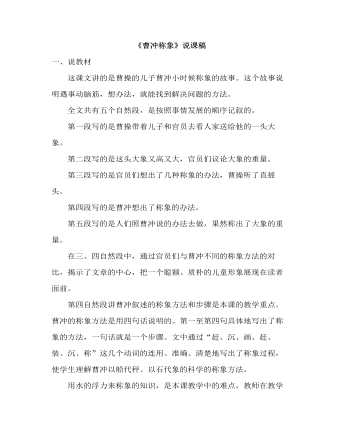
部编人教版二年级上册《曹冲称象》说课稿
全文共有五个自然段,是按照事情发展的顺序记叙的。第一段写的是曹操带着儿子和官员去看人家送给他的一头大象。第二段写的是这头大象又高又大,官员们议论大象的重量。第三段写的是官员们想出了几种称象的办法,曹操听了直摇头。第四段写的是曹冲想出了称象的办法。第五段写的是人们照曹冲说的办法去做,果然称出了大象的重量。在三、四自然段中,通过官员们与曹冲不同的称象方法的对比,揭示了文章的中心,把一个聪颖、质朴的儿童形象展现在读者面前。第四自然段讲曹冲叙述的称象方法和步骤是本课的教学重点。曹冲的称象方法是用四句话说明的。第一至第四句具体地写出了称象的方法,一句话就是一个步骤。文中通过“赶、沉、画、赶、装、沉、称”这几个动词的连用、准确、清楚地写出了称象过程,使学生理解曹冲以船代秤、以石代象的科学的称象方法。用水的浮力来称象的知识,是本课教学中的难点,教师在教学中要努力使文章中抽象的语言文字具体化,以帮助学生理解曹冲称象的具体方法和步骤。
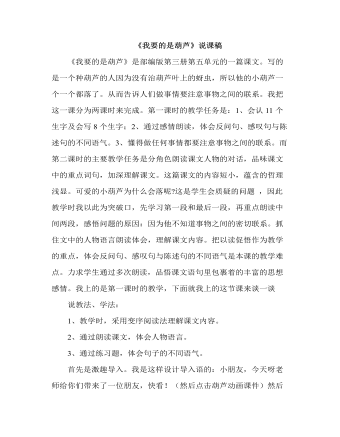
部编人教版二年级上册《我要的是葫芦》说课稿
我要的是葫芦》是部编版第三册第五单元的一篇课文。写的是一个种葫芦的人因为没有治葫芦叶上的蚜虫,所以他的小葫芦一个一个都落了。从而告诉人们做事情要注意事物之间的联系。我把这一课分为两课时来完成。第一课时的教学任务是:1、会认11个生字及会写8个生字;2、通过感情朗读,体会反问句、感叹句与陈述句的不同语气。3、懂得做任何事情都要注意事物之间的联系。而第二课时的主要教学任务是分角色朗读课文人物的对话,品味课文中的重点词句,加深理解课文。这篇课文的内容短小,蕴含的哲理浅显。可爱的小葫芦为什么会落呢?这是学生会质疑的问题 ,因此教学时我以此为突破口,先学习第一段和最后一段,再重点朗读中间两段,感悟问题的原因:因为他不知道事物之间的密切联系。
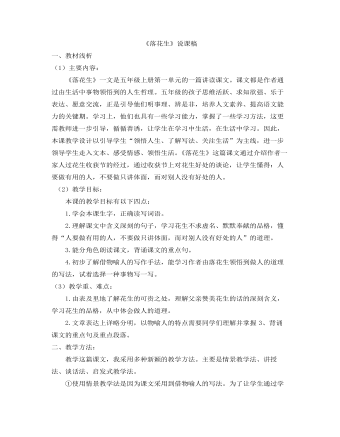
部编人教版五年级上册《 落花生》说课稿
(1)主要内容:《落花生》一文是五年级上册第一单元的一篇讲读课文。课文都是作者通过由生活中事物领悟到的人生哲理。五年级的孩子思维活跃、求知欲强、乐于表达、愿意交流,正是引导他们明事理、辨是非,培养人文素养、提高语文能力的关键期。学习上,他们也具有一些学习能力,掌握了一些学习方法,这更需教师进一步引导,循循善诱,让学生在学习中生活,在生活中学习。因此,本课教学设计以引导学生“领悟人生、了解写法、关注生活”为主线,进一步领导学生走入文本、感受情感、领悟生活。《落花生》这篇课文通过介绍作者一家人过花生收获节的经过,通过收获节上对花生好处的谈论,让学生懂得:人要做有用的人,不要做只讲体面,而对别人没有好处的人。(2)教学目标:本课的教学目标有以下四点:1.学会本课生字,正确读写词语。
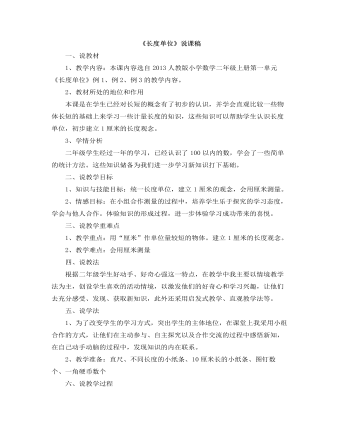
小学数学人教版二年级上册《长度单位》说课稿
一、说教材1、教学内容:本课内容选自2013人教版小学数学二年级上册第一单元《长度单位》例1、例2、例3的教学内容。 2、教材所处的地位和作用本课是在学生已经对长短的概念有了初步的认识,并学会直观比较一些物体长短的基础上来学习一些计量长度的知识,这些知识可以帮助学生认识长度单位,初步建立1厘米的长度观念。 3、学情分析二年级学生经过一年的学习,已经认识了100以内的数,学会了一些简单的统计方法。这些知识储备为我们进一步学习新知识打下基础。二、说教学目标1、知识与技能目标:统一长度单位,建立1厘米的观念,会用厘米测量。2、情感目标:在小组合作测量的过程中,培养学生乐于探究的学习态度,学会与他人合作。体验知识的形成过程,进一步体验学习成功带来的喜悦。
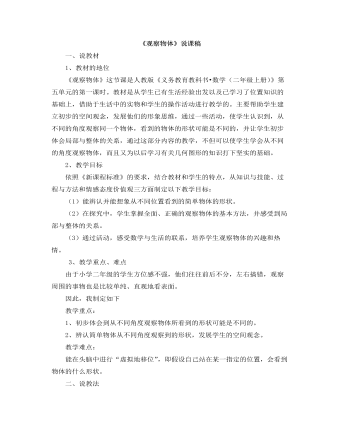
小学数学人教版二年级上册《观察物体》说课稿
1、教材的地位《观察物体》这节课是人教版《义务教育教科书?数学(二年级上册)》第五单元的第一课时。教材是从学生已有生活经验出发以及已学习了位置知识的基础上,借助于生活中的实物和学生的操作活动进行教学的。主要帮助学生建立初步的空间观念,发展他们的形象思维,通过一些活动,使学生认识到,从不同的角度观察同一个物体,看到的物体的形状可能是不同的,并让学生初步体会局部与整体的关系,通过这部分内容的教学,不但可以使学生学会从不同的角度观察物体,而且又为以后学习有关几何图形的知识打下坚实的基础。 2、教学目标依照《新课程标准》的要求,结合教材和学生的特点,从知识与技能、过程与方法和情感态度价值观三方面制定以下教学目标:(1)能辨认并能想象从不同位置看到的简单物体的形状。 (2)在探究中,学生掌握全面、正确的观察物体的基本方法,并感受到局部与整体的关系。 (3)通过活动,感受数学与生活的联系,培养学生观察物体的兴趣和热情。3、教学重点、难点由于小学二年级的学生方位感不强,他们往往前后不分,左右搞错,观察周围的事物也是比较单纯、直观地看表面。
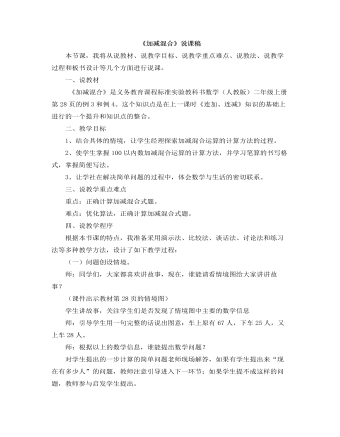
小学数学人教版二年级上册《加减混合》说课稿
一、说教材《加减混合》是义务教育课程标准实验教科书数学(人教版)二年级上册第28页的例3和例4。这个知识点是在上一课时《连加、连减》知识的基础上进行的一个提升和知识点的整合。二、教学目标 1、结合具体的情境,让学生经理探索加减混合运算的计算方法的过程。 2、使学生掌握100以内数加减混合运算的计算方法,并学习笔算的书写格式,掌握简便写法。 3、让学社在解决简单问题的过程中,体会数学与生活的密切联系。三、说教学重点难点重点:正确计算加减混合式题。 难点:优化算法,正确计算加减混合式题。 四、说教学程序 根据本节课的特点,我准备采用演示法、比较法、谈话法、讨论法和练习法等多种教学方法,设计了如下教学过程:

小学数学人教版五年级上册《小数乘小数》说课稿
一、说教材小数乘以小数的原有基础是整数乘整数、小数乘整数。它为小数除法、小数四则混合运算和分数小数四则混合运算学习奠定基础,占据着重要的地位。小数乘小数是五年级上册第一单元小数乘法的难点和关键,一共涉及三个知识点,1.确定积小数点位置;2.积位数不够时添“0”补足;3.小数连乘的探究。第一课时是根据整数乘法算出积后来确定积的小数点位置,不涉及积位数不够时用0来补足的知识。本课时的关键在于理解算理,归纳算法。根据以上的分析及新课程标准的要求,考虑到学生已有的认知结构,对整数乘法算理的掌握,能对小数乘整数积小数点的定位,制定以下的教学目标:知识与能力:共同探讨,理解并掌握小数乘小数的算理及算法;过程与方法:在探索过程中,培养学生观察、比较、归纳与概括的能力和用数学语言进行表述交流的能力,渗透转化思想;
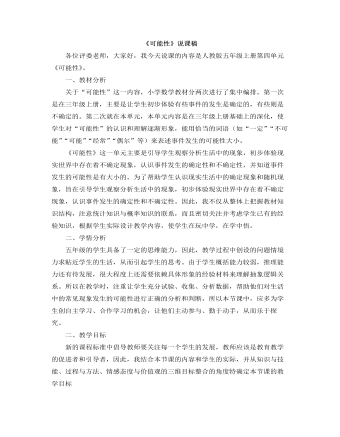
小学数学人教版五年级上册《可能性》说课稿
二、学情分析五年级的学生具备了一定的思维能力,因此,教学过程中创设的问题情境力求贴近学生的生活,从而引起学生的思考。由于学生概括能力较弱,推理能力还有待发展,很大程度上还需要依赖具体形象的经验材料来理解抽象逻辑关系。所以在教学时,注重让学生充分试验、收集、分析数据,帮助他们对生活中的常见现象发生的可能性进行正确的分析和判断,所以本节课中,应多为学生创自主学习、合作学习的机会,让他们主动参与、勤于动手,从而乐于探究。二、教学目标新的课程标准中倡导教师要关注每一个学生的发展,教师应该是教育教学的促进者和引导者,因此,我结合本节课的内容和学生的实际,并从知识与技能、过程与方法、情感态度与价值观的三维目标整合的角度特确定本节课的教学目标 1.通过试验操作,懂得有些事情的发生是确定的,有些则是不确定的,并用“一定”“不可能”“可能”等词语来描述知道事情发生的可能性是有大有小的,且可能性的大小与物体数量有关。2.经历猜测、试验、收集与分析试验结果等过程。 3培养学生的随机观念以及培养学生判断、推理和合作探究的能力。
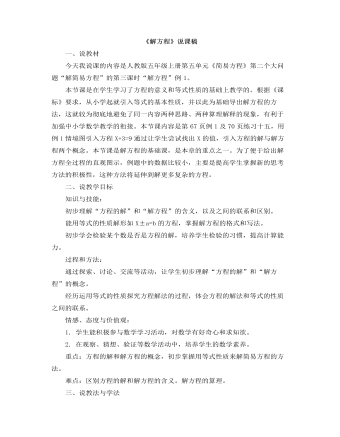
小学数学人教版五年级上册《解方程》说课稿
二、说教学目标知识与技能:初步理解“方程的解”和“解方程”的含义,以及之间的联系和区别。能用等式的性质解形如X±a=b的方程,掌握解方程的格式和写法。初步学会检验某个数是否是方程的解,培养学生检验的习惯,提高计算能力。过程和方法:通过探索、讨论、交流等活动,让学生初步理解“方程的解”和“解方程”的概念。经历运用等式的性质探究方程解法的过程,体会方程的解法和等式的性质之间的联系。情感、态度与价值观:1. 学生能积极参与数学学习活动,对数学有好奇心和求知欲。2. 在观察、猜想、验证等数学活动中,培养学生的数学素养。重点:方程的解和解方程的概念,初步掌握用等式性质来解简易方程的方法。难点:区别方程的解和解方程的含义。解方程的算理。三、说教法与学法教法:新课标指出,教师是学习的组织者、引导者、合作者,充分发挥学生的主体性。根据这一理念,我在教学中通过观察、猜想、验证等方式,自主探索、自主学习。有目的地运用知识迁移的规律,引导学生进行观察、比较、分析、概括,培养学生的逻辑思维能力。学法:①让学生学会以旧引新,掌握并运用知识迁移进行学习的方法;②让学生学会自主发现问题,分析问题,解决问题的方法。
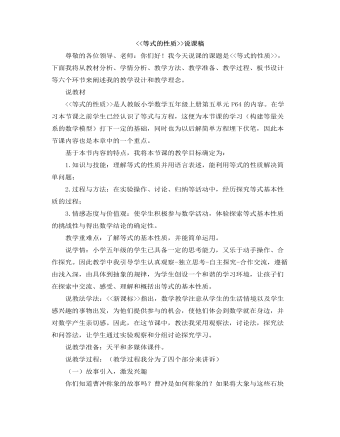
小学数学人教版五年级上册《等式的性质》说课稿
说教材>是人教版小学数学五年级上册第五单元P64的内容。在学习本节课之前学生已经认识了等式与方程,这便为本节课的学习(构建等量关系的数学模型)打下一定的基础,同时也为以后解简单方程埋下伏笔,因此本节课内容也是本章中的一个重点。基于本节内容的特点,我将本节课的教学目标确定为:1.知识与技能:理解等式的性质并用语言表述,能利用等式的性质解决简单问题;2.过程与方法:在实验操作、讨论、归纳等活动中,经历探究等式基本性质的过程;3.情感态度与价值观:使学生积极参与数学活动,体验探索等式基本性质的挑战性与得出数学结论的确定性。教学重难点:了解等式的基本性质,并能简单运用。说学情:小学五年级的学生已具备一定的思考能力,又乐于动手操作、合作探究。因此教学中我引导学生认真观察-独立思考-自主探究-合作交流,遵循由浅入深,由具体到抽象的规律,为学生创设一个和谐的学习环境,让孩子们在探索中交流、感受、理解和概括出等式的基本性质。
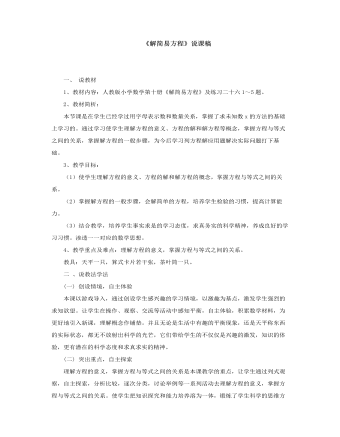
小学数学人教版五年级上册解简易方程说课稿
一、 说教材1、教材内容:人教版小学数学第十册《解简易方程》及练习二十六1~5题。2、教材简析:本节课是在学生已经学过用字母表示数和数量关系,掌握了求未知数x的方法的基础上学习的。通过学习使学生理解方程的意义、方程的解和解方程等概念,掌握方程与等式之间的关系,掌握解方程的一般步骤,为今后学习列方程解应用题解决实际问题打下基础。3、教学目标:(1)使学生理解方程的意义、方程的解和解方程的概念,掌握方程与等式之间的关系。(2)掌握解方程的一般步骤,会解简单的方程,培养学生检验的习惯,提高计算能力。(3)结合教学,培养学生事实求是的学习态度,求真务实的科学精神,养成良好的学习习惯。渗透一一对应的数学思想。